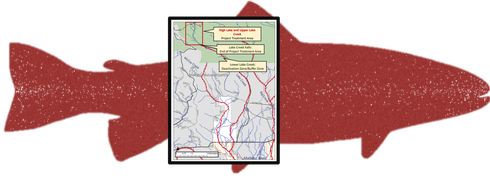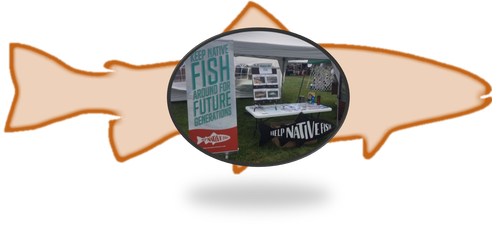What is a Native Fish?
Fish that have always been here!Oregon’s native fish love the cold, clean waters of the Upper Malheur. Non-native and invasive fish are species which did not historically occur in the area and were introduced by humans. Non-native, invasive fish also love Oregon’s cold, clean waters BUT they disrupt the freshwater ecosystem. The continued existence of some of our native fish species in Eastern Oregon is threatened. Learn about how we can keep our fisheries around for generations to come.
Already an expert? Take our Quiz! |
The Problem: invasive species threaten native fish
Current management efforts focus on invasive brook trout RemovalBooming populations of invasive fish are a problem! Too much competition for food, degradation of habitat (lack of riparian (streambank) shade and cold water), and cross-breeding with these invasive fish make it difficult for native fish to survive.
Currently, Help Native Fish is focused on Malheur River Bull Trout (Salvelinus confluentus) a native species under threat of extinction and negatively impacted by introduced brook trout. |
High Lake and Upper Lake Creek - Brook Trout Eradication Proposal
|
|
Proposed High Lake and Upper Lake Creek Rotenone TreatmentWho? The Technical Advisory Committee (TAC)
What? The proposal is to treat High Lake (5.8 acres) and its outflow, upper Lake Creek, downstream to Lake Creek Falls (approximately 1.7 miles) with the naturally derived piscicide rotenone to eradicate invasive Brook Trout. Rotenone is a commonly used fisheries management tool, is quickly broken down by the natural environment, and will be deactivated at the end of the treatment reach. Rotenone has no effect on the ecosystem outside of the aquatic environment and monitoring will be done to document the environmental fate of rotenone and document eradication of Brook Trout to assure aquatic recovery. In addition, salvage operations will be conducted immediately downstream of the deactivation station to relocate native fish from this area to prevent incidental stress or disturbance. (Click to learn more) |
The Burns Paiute Tribe and the Agai
|
Click to learn more about the BPT Salmon and Steelhead Effort
|
2024 Salmon HomecomingFor thousands of years, salmon fishing was a way of life and important part of the seasonal round for ancestors of Burns Paiute Tribe. Tribal descendants recognize their native rights to salmon subsistence in aboriginal territories and former reservation lands of the Malheur Basin. [...] BPT recovery goals specifically address the restoration of anadromous Chinook and Steelhead runs to the Malheur River. - Malheur River Broad Sense Recovery Goals
Credit: Northern Paiute Seasonal Round - Couture et al. 1986 |
The Burns Paiute Tribe and Native Fish Conservation
The BPT Fisheries ProgramThe Burns Paiute Tribe Fisheries Program “Primarily, the BPT Fisheries Program seeks to protect, restore and enhance native fish species assemblages in the Malheur River with an emphasis on ESA-listed Bull Trout as a focal species.” BPT Annual Reports |
Current Focus: Malheur RIver BUll Trout
Bull trout were listed as esa threatened in 1999Since then, recovery efforts have been made by multiple agencies. Help Native Fish is a campaign spearheaded through the Burns Paiute Tribe and the Malheur River Bull Trout Technical Advisory Committee. With help from partner agencies, we are actively working on the conservation and recovery of the Upper Malheur River Bull Trout population. |
Want to Learn More?
Come talk to us!The BPT Fisheries Program can often be found behind their HelpNativeFish booth at the summer fairs, community events, Migratory Bird Days, and other outreach events! We are excited to provide information on Malheur River Fish, our current management projects, our future restoration/conservation plans, and challenge you to play our 'Guess the Fish' game.
Please check this page for future 2023 events or scroll down to contact us directly. |
|
IMPORTANT REMINDER: DON'T MOVE FISH
NON-AUTHORIZED TRANSPORTATION OF FISH BETWEEN WATERWAYS IS ILLEGAL, CAN CAUSE ECOLOGICAL HARM AND CREATES COSTLY REMOVAL PROJECTS. SPENDING TIME AND MONEY TO REMOVE UNWANTED FISH MEANS THAT LESS MONEY IS AVAILABLE TO ENHANCE EXISTING FISHERIES AND IMPROVE RECREATIONAL OPPORTUNITIES. |
what you can do
|
Angling? Know your fish species – what species to keep and what species to release. And don’t transport fish between waterways: it’s illegal and creates costly removal projects.
Check Oregon fishing regulations and visit myodfw.com to find out more. |
|
Manage cattle or livestock? Use best management practices to ensure healthy stream conditions and production needs are both met.
|
|
Own or use streamside property? Think about ways you can keep your streams cold and well-shaded. Talk to your local Soil and Water Conservation District for assistance.
|
|
Use trails or camp on public and private lands? Stick to established trails and give lakes and streams plenty of room when setting up camp. Find out what to Know Before You Go at www.fs.fed.us.
Learn more about trout species in Oregon! Take the Help Native Fish Quiz to test your knowledge.
With your help we can work towards a future where native fish thrive as part of a healthy ecosystem that offers top-notch angling opportunities and lasting cold water habitat. |
AboutThe Help Native Fish educational materials were created in 2018 to raise awareness about what people who live, work, and recreate near riparian areas can do to help native fish. Currently the materials have been implemented throughout Eastern Oregon.
Our teamThe Technical Advisory Committee of the Malheur River Working Bull Trout Group includes Oregon Department of Fish and Wildlife, Bureau of Reclamation, US Fish and Wildlife Service, the US Forest Service, and the Burns Paiute Tribe. The Technical Advisory Committee is coordinated by the Burns Paiute Tribe Natural Resources Department.
|
Questions about what you can do or want to learn more?
Contact the fisheries manager at the Burns Paiute Tribe by using the contact form below. |












